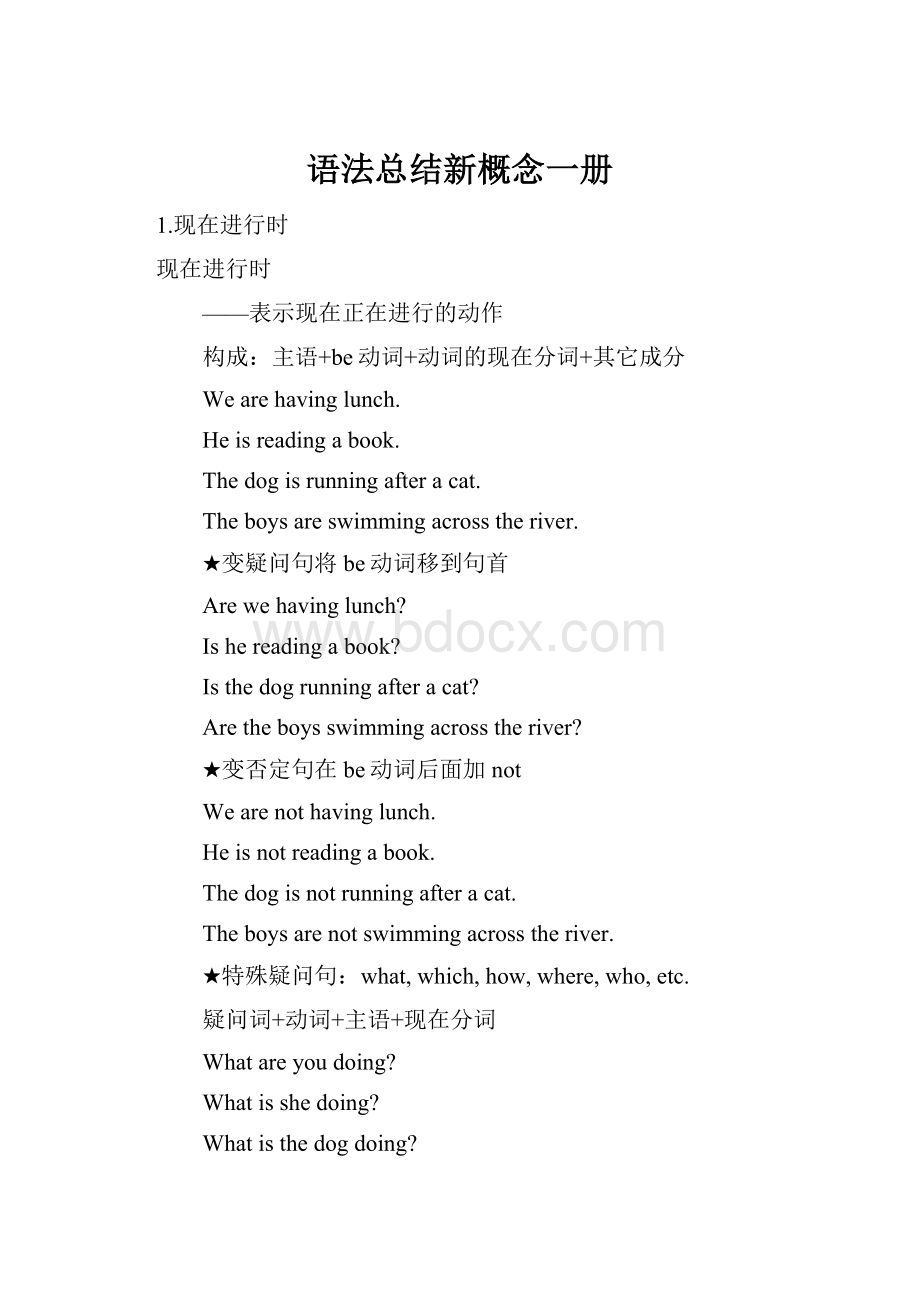语法总结新概念一册.docx
《语法总结新概念一册.docx》由会员分享,可在线阅读,更多相关《语法总结新概念一册.docx(10页珍藏版)》请在冰豆网上搜索。

语法总结新概念一册
1.现在进行时
现在进行时
——表示现在正在进行的动作
构成:
主语+be动词+动词的现在分词+其它成分
Wearehavinglunch.
Heisreadingabook.
Thedogisrunningafteracat.
Theboysareswimmingacrosstheriver.
★变疑问句将be动词移到句首
Arewehavinglunch?
Ishereadingabook?
Isthedogrunningafteracat?
Aretheboysswimmingacrosstheriver?
★变否定句在be动词后面加not
Wearenothavinglunch.
Heisnotreadingabook.
Thedogisnotrunningafteracat.
Theboysarenotswimmingacrosstheriver.
★特殊疑问句:
what,which,how,where,who,etc.
疑问词+动词+主语+现在分词
Whatareyoudoing?
Whatisshedoing?
Whatisthedogdoing?
没有进行时的动词(必背)
表示状态,思想,感情和感觉的动词不能表示正在进行的动作:
1.表示感觉,感官的词
see,hear,like,love,want
2.have,has当“拥有”讲时没有进行时
2.一般现在时
一般现在时——表示一般性,经常性的动作或一般性事实。
1、含有be动词的句子
Heisateacher.
Thegirlisverybeautiful.
TimandJackarestudents.
★变疑问句将be动词移到句首
Isheateacher?
Isthegirlverybeautiful?
AreTimandJackstudents?
★变否定句在be动词后面加not
Heisnotateacher.
Thegirlisnotverybeautiful.
TimandJackarenotstudents.
★肯定回答及否定回答
Yes,heis./No,heisnot.
Yes,sheis./No,sheisnot.
Yes,theyare./No,theyarenot.
2、不含有be动词的句子,即含有一般动词的句子。
(1)第三人称单数及单数名词
Helikesbooks.
Shelikeshim.
Thedoglikesbones.
★变疑问句在句首加does,动词变为原型
Doeshelikebooks?
Doesshelikehim?
Doesthedoglikebones?
★变否定句在主语及动词之间加doesn't,动词变为原型,原句中的动词不再有第三人称变化。
Hedoesn'tlikebooks.
Shedoesn'tlikehim.
Thedogdoesn'tlikebones.
★肯定回答及否定回答:
Yes,hedoes./No,hedoesn't.
Yes,shedoes./No,shedoesn't
Yes,itdoes./No,itdoesn't.
注意:
第三人称单数形式一般在动词后面加S,不要和名词复数混淆,变否定句或疑问句时名词复数没有任何变化。
(2)其他人称及复数名词
Iwanttohaveabath.
Wehavesomemeat.
Thestudentslikesmartteachers.
★变疑问句在句首加do
Doyouwanttohaveabath?
Dowehaveanymeat?
Dothestudentslikesmartteachers?
★变否定句在主语和动词之间加don't.
Youdon'twanttohaveabath.
Wedon'thaveanymeat.
Thestudentsdon'tlikesmartteachers.
★肯定回答及否定回答
Yes,Ido./No,Idon't.
Yes,wedo./No,wedon't
Yes,theydo./No,theydon't.
3.一般将来时
一般将来时
——表示将来将要发生的动作,经常和tomorrow,nextyear,thedayaftertomorrow,theyearafterthenext,infivehours'time,etc.表示将来的词联用。
结构:
主语+助动词will+动词原形
IwillgotoAmericatomorrow.
ThepilotwillflytoJapanthemonthafterthenext.
Jackwillmoveintohisnewhousetomorrowmorning.
★变疑问句将助动词移到句首
WillyougotoAmericatomorrow?
WillthepilotflytoJapanthemonthafterthenext?
WillJackmoveintohisnewhousetomorrowmorning?
★变否定句在助动词后面加not
IwillnotgotoAmericatomorrow.
ThepilotwillnotflytoJapanthemonthafterthenext.
Jackwillnotmoveintohisnewhousetomorrowmorning.
★肯定回答及否定回答
Yes,Iwill./No,Iwillnot.
Yes,he/shewill./No,he/shewillnot.
Yes,hewill./No,hewillnot.
★特殊疑问句
Whatwillyoudo?
4.一般过去时
一般过去时
表示过去发生的动作或事件,常和表示过去的时间状语连用,如yesterday,lastnight,thedaybeforeyesterday,3daysago...
含有be动词的句子,将be动词变为过去式。
am,is的过去式为was,are的过去式为were:
Iwasatthebutcher's.
Youwereastudentayearago.
Theteacherwasverybeautifultenyearsago.
★变疑问句将be动词移动到句首
Wereyouatthebutcher's?
Wereyouastudentayearago?
Wastheteacherverybeautifultenyearsago?
★变否定句在be动词后面加not
Iwasnotatthebutcher's.
Youwerenotastudentayearago.
Theteacherwasnotverybeautifultenyearsago.
★肯定回答否定回答
Yes,Iwas./No,Iwasnot.
Yes,youwere./No,youwerenot.
Yes,he/shewas./No,he/shewasnot.
★特殊疑问句
Whatdidyoudo?
(必背)
不含有be动词的句子,将动词变为过去式:
Ifinishedmyhomeworkyesterday.
Theboywenttoarestaurant.
TheSawyerslivedatKingStreetayearago.
★变疑问句在句首加did,动词变为原型
Didyoufinishyourhomeworkyesterday?
Didtheboygotoarestaurant?
DidtheSawyersliveatKingStreetayearago?
★变否定句在主语和动词之间加didnot
Ididnotfinishmyhomeworkyesterday.
Theboydidnotgotoarestaurant.
TheSawyersdidnotliveatKingStreetayearago.
★肯定回答及否定回答
Yes,Idid./No,Ididn't.
Yes,hedid./No,hedidn't.
Yes,theydid./No,theydidnot.
5.现在完成时
现在完成时
构成:
主语+助动词have,has+过去分词
用法:
1)表示过去发生的和现在有某种联系的动作,常和just,usually,already,since等时间副词连用。
Ihavejusthadlunch.(饱了,不用再吃了。
)
Hehashadacupoftea.(不渴了,不用再喝。
)
Theyhavealreadyhadtheirholiday.(不能再度假了。
)
Theboyhasalreadyreadthebook.(已经知道书的内容了,不用再看了。
)
2)询问别人是否做过某事一般用现在完成时:
Haveyoufinishedyourhomework?
HaveyoubeentoBeijing?
Haveheseenthefilm?
3)表示开始于过去并持续到现在的动作
IhavelivedinBeijingfortwentyyears.
Ihaveworkedforthisschoolfor1year.
4)表示一种经历,经验:
去过…地方,做过…事情,经历过…事情
Ihaveneverhadabath.
Ihaveneverseenafilm.
Ihaveneverbeentocinema.
IhaveeverbeentoParis.
Havebeento表示去过,havegoneto表示去了
IhavebeentoLondon.(人已经回来)
HehasgonetoLondon.(人还在那里)
5)表示一种结果,一般不和时间副词联用
Ihavelostmypen.
Ihavehurtmyself.
Hehasbecomeateacher.
Shehasbrokenmyheart.
句型变化:
★变疑问句将助动词移到句首,变否定句在助动词后面加not.
Haveyoulostyourpen?
Ihavenotlostmypen.
★肯定回答及否定回答
Yes,Ihave./No,Ihavenot.
★特殊疑问句
Whathaveyoudone?
Whathashedone?
一般过去时与现在完成时的区别:
凡是有明确的表示过去的时间状语的句子为过去时。
注意:
有些动词表示的动作有一个终点,不能再延续,因此不能和表示一段时间状语连用。
错:
I’veleftBeijingfor3days.
对:
IleftBeijing3daysago.Ihavebeenawayfrombeingfor3days.
6.过去将来时
结构:
woulddo
Shesaidshewouldgoherethenextmorning.
两个特殊句型:
therebe句型,begoingto结构
1)Begoingto结构
表示打算,准备,计划做某事
★结构:
主语+be动词+goingto+动词原型
Iamgoingtomakeabookcase.
Theyaregoingtopaintit.
Thefatherisgoingtogivethebookcasetohisdaughter.
★变疑问句将be动词移到句首
Areyougoingtomakeabookcase?
Aretheygoingtopaintit?
Isthefathergoingtogivethebookcasetohisdaughter?
★变否定句在be动词后面加not
Iamnotgoingtomakeabookcase.
Theyaregoingtopaintit.
Thefatherisnotgoingtogivethebookcasetohisdaughter.
★肯定回答及否定回答
Yes,Iam.No,Iamnot.
Yes,theyare.No,theyarenot.
Yes,heis.No,heisnot.
★特殊疑问句
Whatareyougoingtodo?
Whataretheygoingtodo?
Whatisthefathergoingtodo?
(必背)
2)Therebe句型
表示哪里有什么东西(某处有某物)
Thereis+单数名词+表示场所的词(一般为介词词组)
Thereisabookinthisroom.
Thereisapenonthetable
Thereare+复数名词+表示场所的词(一般为介词词组)
Therearetwopensonthetable.
Therearethreeschoolsthere.
★变疑问句将be动词移到句首
Isthereabookinthisroom?
Aretheretwopensonthetable?
★变否定句在动词后面加not
Thereisnotabookinthisroom.
Therearenottwopensonthetable.
★肯定回答及否定回答
Yes,thereis.No,thereisnot.
Yes,thereare.No,therearenot.
7.过去进行时
过去进行时
表示过去正在进行的动作,经常用在when,while,as引导的状语从句中。
结构:
was/were+doing
Whenmyhusbandwasgoingintothediningroomthismorning,hedroppedsomecoinsonthefloor.
Whilewewerehavingdinner,myfatherwaswatchingTV.